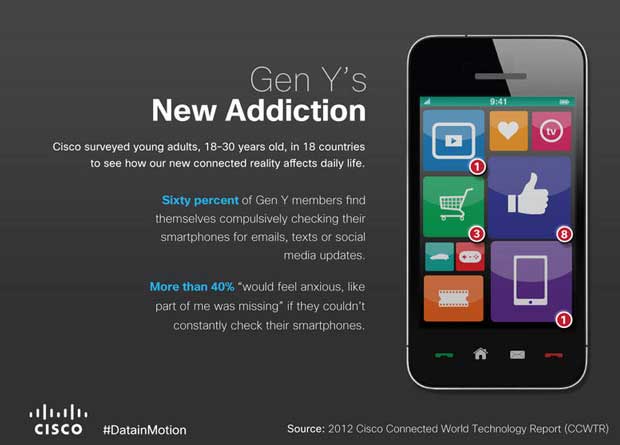THUNDER BAY – Have you ever sat down at a table to enjoy a meal with a person who remains glued to their smart phone? Are you shaking if your smart phone battery dies and you forgot your charger at home? You are likely a typical Gen Y member. There change in how people live their lives with social media and technology is changing all the time, and as new phones, faster mobility service, and extended coverage reach ever forward in our daily lives, that rush to technology continues to grow.

Carlie and her friend Cass at Fort William Gardens
Attending a concert, or a sporting event, Gen Y are multi-tasking.
Often people seem more focused on capturing the moment on their digital device than in sitting back and enjoying the entertainment. For growing numbers of people, their smartphone is an extension of their hand, a 207th bone in their bodies.
The contrast to earlier generations is stark. It might even be a source for family debate over the coming holiday season as Gen Y engages with each other during what parents, grandparents and family consider ‘family time’.
Ninety percent of Gen Y surveyed worldwide said they check their smartphones for updates in email, texts and social media sites, often before they get out of bed, according to the 2012 Cisco® Connected World Technology Report (CCWTR.) There are 206 bones in the human body, and the smartphone could plausibly be considered the 207th for Gen Y. Two out of five said they “would feel anxious, like part of me is missing,” if they couldn’t use their smartphones to stay connected.
Based on a survey conducted by InsightExpress of 1,800 college students and young professionals aged 18 to 30 across 18 countries, the report examines how Generation Y uses the Internet and mobile devices to connect with the world around them. The report reveals their behavior and attitudes about the creation, access and privacy of the enormous amounts of data being generated daily by smartphones, sensors, video cameras, monitors and other connected devices.
Mobile devices are just the beginning. As more and more people, processes, data and things join and interact on the “Internet of Everything,” the volume and potential value of all the data generated by those connections grow exponentially.
Key Findings of the 2012 Cisco Connected World Technology Report
The new morning routine: toothpaste, toilet paper and texting
Gen Y does not want to miss anything. Checking their mobile devices for text, email and social media updates is how they start their day — often even before getting out of bed. For this generation, information is real-time, all the time.
- Nine of 10 respondents globally will get dressed, brush their teeth, and want to check their smartphones as part of the morning ritual for getting ready for school or work.
- For employers, this is meaningful because it demonstrates that the workforce of the future is more agile, more informed and more responsive than any previous generation. They live to connect and communicate.
Me and my smartphone. From morning through night, Gen Y stays constantly connected.
- More than one in four Gen Y respondents (29 percent) say they check their smartphones so constantly that they lose count.
- Globally, one in five checks a smartphone for email, text and social media updates at least every 10 minutes. In the U.S., two out of five check at least once every 10 minutes.
- One-third of respondents check their smartphones at least once every 30 minutes; in the U.S., that figure jumps to more than 50 percent.
Connected or addicted?
- Sixty percent of Gen Yers subconsciously or compulsively check their smartphones for emails, texts or social media updates.
- Of those, women are more driven to connect: 85 percent of women versus 63 percent of men find themselves often compulsively checking their smartphone for text, emails or social media updates.
- Over 40 percent of respondents would go through a “withdrawal” effect and “would feel anxious, like part of me was missing,” if they couldn’t check their smartphones constantly.
- Of those compulsive smart phone users, 60 percent wish they didn’t feel so compelled.
Information Technology professionals are even more connected
- Almost one third of IT professionals stated they check their smartphones “continuously.”
- 40 percent of IT professionals said they check their smartphones at least every 10 minutes.
They’re everywhere! Smartphones are used everywhere, even in the most private of places. The craving to stay connected means that the lines between work and social life/family life are blurring. People check for work updates and communicate at all hours from every place imaginable. Time is elastic: For Generation Y there are no clear markers between “the workday” and personal time — both blend and overlap throughout the day and night.
- Is romance dead? Globally, 3 out of 4 respondents use smartphones in bed.
- Don’t forget to wash your hands: Over a third use smartphones in the bathroom.
- Set a place at the table: Almost half of the global respondents (46 percent) said they text, email and check social media during meals with family and friends. More than half of American respondents (56 percent) use smartphones during social meals.
- Watch out! Dangerous as it is, almost one in five admits to texting while driving.
Not just text and email: The apps revolution
- Nearly 70 percent of the Gen Y respondents said mobile applications are important to their daily lives.
- More than half said they mainly use mobile applications for games and entertainment.
- Yet one in four (27 percent) mainly use mobile applications for work.
How many apps do you need? Vendors advertise thousands of applications in their app stores, but are those apps being used? Of all the apps being downloaded daily, a surprisingly low number are used on a regular basis.
- The majority of Gen Y respondents (70 percent) report using fewer than 10 smartphone apps regularly.
- Only one in four (24 percent) respondents said they use 10 to 25 apps regularly
Online friendship versus in-person: The online community knows no bounds of geography or time zones
- Forty percent spend more time visiting online with friends than socializing in person.
- Two-thirds of respondents said they spend an equal amount of time, or more, socializing online with friends than they do in person.
- But there’s a gender difference: 38 percent of men worldwide spend more time in-person with friends than online, versus 29 percent of women.
Who are you really? Online and real-world identities aren’t the same.
Connecting online creates opportunities to stretch everyday boundaries and try out a new persona — but on the flip side, it can lay the foundation for deception. How much can you trust what you read online?
- Four of five (81 percent) respondents believe that people have different online and offline identities.
- Over a third of the respondents felt that most people have very different online versus offline identities.
- When asked about themselves, only 44 percent said their online identity was the same as their real-world “offline” identity.
Will smartphones replace laptops in the workplace?
In many parts of the world, smartphones now rival laptops as the single most desired device by 18 to 30 year-olds. It is seen as the most versatile and the most compact.
- If they had to choose only one device, a third of the respondents preferred a smartphone, while slightly more than a third favored laptops.
- Smartphones have surpassed desktop computers as the preferred workplace device from a global perspective.
- Smartphones were rated twice as popular as a desktop PC and three times as popular as a tablet.
For the “always-connected” generation, a single mobile device will do, whether it is a personal device or a company-owned device, which creates challenges for the IT managers who must safeguard company assets and information.
- While two out of five said their company’s policy forbids them to use company-issued devices for non-work activities, nearly three out of four (71 percent) said they don’t always obey those policies.
- Two-thirds (66 percent) feel that “employers should not track employees’ online activities — it’s none of their business.”
- IT professionals know that many employees don’t follow the rules, but they don’t understand how prevalent it is: Over half of IT professionals globally thought their employees obey the policy on not using work devices for personal use.
Online shopping — global Gen Y trend
- Nine out of 10 Gen Y surveyed said they engage in online shopping.
- Nearly three out of five (58 percent) report they regularly rely on customer reviews when deciding on online purchases; an additional 28 percent consult online reviews occasionally.
- Fifty-seven percent — almost 3 out of five — are willing to share their email address with stores and online sites in order to receive notices about discounts and sales. But they are wary of sharing much more than that — few are willing to share phone number, home address or other personal data.
Fueling the world’s data
- Almost 90 percent upload photos to share or store on Internet sites.
- 62 percent upload videos to share or store on Internet sites.
- Facing the world: 87 percent have a Facebook account, and one in 10 have Facebook always up.
- 41 percent update Facebook at least once a day, and over one in five update Facebook several times a day.
- 56 percent of respondents have a Twitter account, and 21 percent tweet at least once a day.
About the Study
The third in an annual series, the 2012 Cisco Connected World Technology Report, was commissioned by Cisco and conducted by InsightExpress, an independent market research firm based in the United States. The global study consists of two surveys: one focused on college students and workers aged 18 to 30, and the second focused on IT professionals. Each survey includes 100 respondents from each of 18 countries: United States, Canada, Mexico, Brazil, Argentina, United Kingdom, France, Germany, Netherlands, Russia, Poland, Turkey, South Africa, India, China, Japan, South Korea, and Australia.
SUPPORTING RESOURCES
- Visit website: Cisco Connected World Technology Report
- Discover: “What is your data footprint”
- View video: Gen Y and Technology
- Read: Cisco Blogs
- Learn about: The Internet of Everything
- Learn about: Data in Motion
- Learn more: Mobility
- Learn more: Cloud







